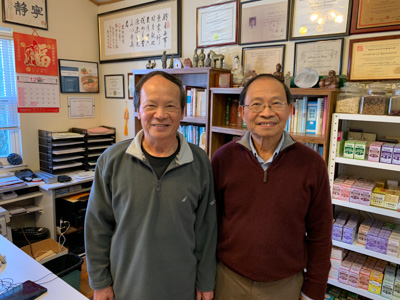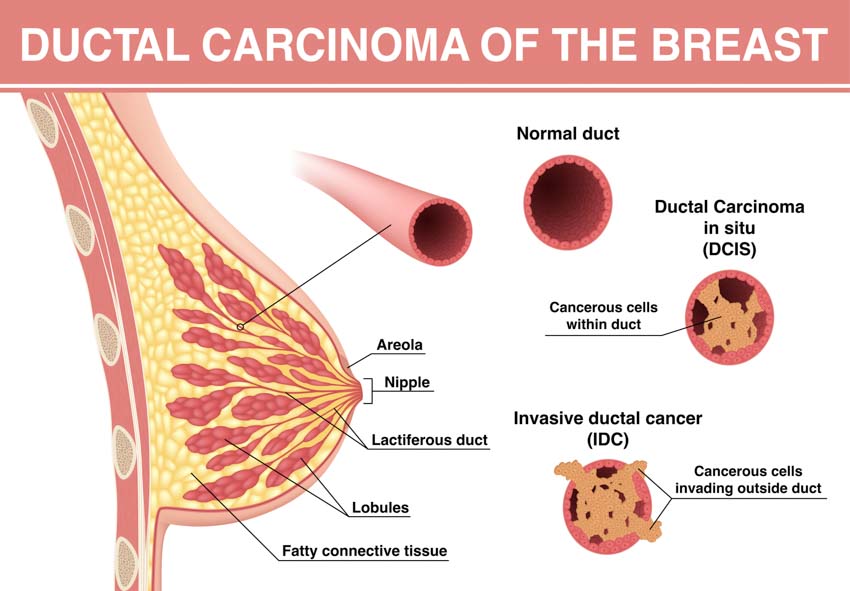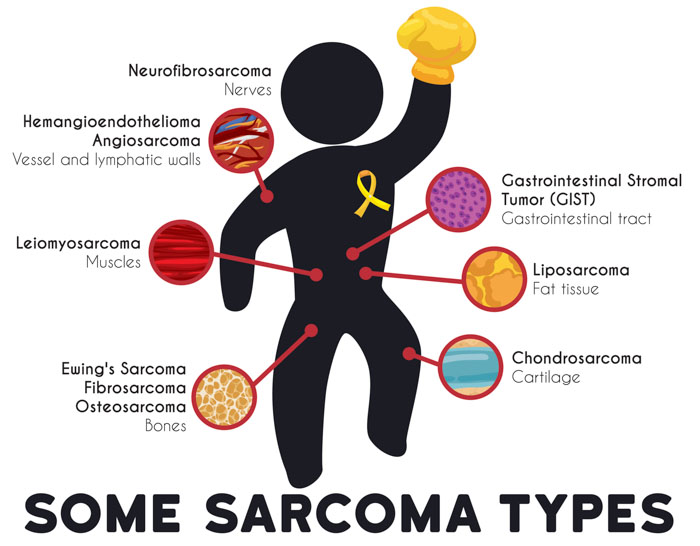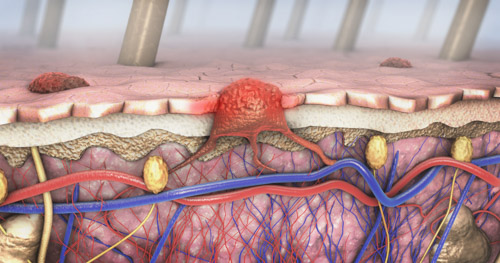Oncology
Acupuncture Course Samples
 Ken Pang, L.Ac. and Prof. Jeffrey Pang, L.Ac.
Ken Pang, L.Ac. and Prof. Jeffrey Pang, L.Ac.
Sample from Biomedical section:
Forms of Cancer
There are in excess of 100 types of cancer. Many are named after the original area where the cancer formed or the type of cells involved. In this section we review common types of cancer.
Carcinoma
This is one of the most common forms of cancer, formed by epithelial cells, which are the cells that cover bodily surfaces including the skin, blood vessels, organs, and urinary tract. Different names are given to carcinomas based on the origin of what type of epithelial cell gave rise to the cancer. For example,
"Adenocarcinoma is a cancer that forms in epithelial cells that produce fluids or mucus... Basal cell carcinoma is a cancer that begins in the lower or basal (base) layer of the epidermis, which is a person’s outer layer of skin…. Squamous cell carcinoma is a cancer that forms in squamous cells, which are epithelial cells that lie just beneath the outer surface of the skin. Squamous cells also line many other organs, including the stomach, intestines, lungs, bladder, and kidneys." [1]
1. cancer.gov/about-cancer/understanding/what-is-cancer. 4-15-2020. About Cancer.

More in course materials...
Sarcoma
Cancers that form in soft tissue and bone are sarcomas. This includes lymph vessels, tendons, ligaments, fat, and blood vessels.

Leukemia
Leukemia is cancer originating in the blood-forming tissue of bone marrow. This type of cancer does not form tumors. Leukemia is characterized by “large numbers of abnormal white blood cells (leukemia cells and leukemic blast cells) build up in the blood and bone marrow, crowding out normal blood cells.” This creates issues with the proliferation of normal blood cells and impairs oxygen distribution and fighting infections.
Lymphoblastic leukemia is when the bone marrow produces too many lymphocytes (a white blood cell type). Myeloid leukemia is when the bone marrow produces excess white blood cells and myeloblasts (immature white blood cells) buildup in the bone marrow and blood. This “impairs development of other blood cells, leading to a shortage of red blood cells (anemia) and platelets.”
Melanoma
Melanoma is cancer that forms in pigmented tissues, primarily in the skin. However, any pigmented tissue may be involved, including tissue in the eye. Melanoma originates in cells that become melanocytes, which are responsible for creating melanin (pigment).
The following illustration depicts melanoma that enters the bloodstream and lymphatic tract:

Lymphoma
Lymphoma is a type of cancer originating from T cells or B cells (lymphocytes). These are white blood cells that are abnormal and build-up in lymph nodes and vessels and other areas of the body. Hodgkin lymphoma is the term….
More in course materials…
Sample from Chinese Medicine introduction section...
Chinese Medicine
The treatment of cancer patients is covered in the course material and is based on Pang family treatment strategies and the years of experience in treating cancer patients by Ken Pang, L.Ac. and Prof. Jeffrey Pang, L.Ac. It is our belief that combining Chinese medicine with western medicine is the best choice for patients and increases the ability of the immune system to fight cancer.
Disclaimer: Nothing in this course is intended to indicate that acupuncture or herbal medicine treats or cures cancer. The course materials present TCM and its perspective on supporting cancer patients.
TCM Etiology Of Tumors
- Qi Stagnation
- Blood Stasis
- Dampness
- Heat and Toxins
- Phlegm Stagnation
- Zheng Qi Xu (Good/Upright Qi Deficiency)
In this course, we use the term zheng qi. It is translated as good qi or upright qi, and refers to qi that protects the body and maintains health.
More in course materials…
Sample of course materials:
General Acupuncture Points
Cancer patients suffer from emotional trauma after being diagnosed with cancer. As a result, the following points apply for all cancer patients:
- DU20 (GV20), Yin Tang, PC6, HT7, LV3, LV14, LI4
- Ear Points: Shenmen and points for the Zang-Fu organs related to the specific cancer diagnosis (e.g., Heart, Liver, Kidney, etc.)
More in course materials, including details of acupuncture points…
Sample from cancer pain treatment section:
Acupuncture For Cancer Pain
The following are points that assist in pain relief for specific types of cancer:
- Lung Cancer: LU6, LU10, KD3, PC6, SP4
- Liver Cancer: GB34, LV6
- Stomach Cancer: CV12, ST36
- Breast cancer: CV17, LV14, GB21, SI11
More in course materials, including acupuncture point details…
Sample from treatment principles section:
TCM General Cancer Principles
The following are general treatment principles for supporting patients with cancer.
A. The Relationship of Tonifying Zheng Qi and Expelling Evil
1. Early stage: focus on expelling the evil and slightly tonifying the zheng qi.
2. Middle stage: equally tonify the zheng qi and expel the evil.
3. Late stage: focus on tonifying the zheng qi and slightly expelling the evil.
The aforementioned three principles are general guidelines; however, adjustments are made for specific diagnostic considerations. For example, a patient may be in the stage 1 “early stage” but may require stage 2 “middle stage” treatment strategies.
The term evil refers to unhealthy influences and processes that cause illness. This includes the six evils, which are also called the six pernicious influences: wind, cold, damp, heat, summer heat, dryness. Evil also refers other influences, including bloods stasis and heat toxins.
B. Bian Zheng vs. Bian Bing
Two important ways of looking at disease must be considered: bian zheng (pattern differentiation) and bian bing (disease differentiation). Bian zheng is the classic TCM (traditional Chinese medicine) differentiation of illness into syndrome patterns. This is based on principles including zang-fu syndromes (internal organ syndromes), eight principles/parameters, six stages, four levels, channel diagnostics, san jiao disorders, and qi, blood, and fluid disorders.
Bian bing refers to naming a specific disease based on location or other etiology by disease differentiation (e.g., lung cancer, liver cancer, breast cancer, prostate cancer).
Lung Cancer Clinical Example
Let’s take a look at a real world example from the Pang family clinic. A patient presented with the bian bing diagnosis of lung cancer; however, the bian zheng diagnosis was determined to be spleen qi deficiency with liver fire uprising.
- Bian bing: lung cancer
- Bian zheng: spleen qi deficiency with liver fire uprising
According to TCM principles of pattern differentiation…
More in course materials...
Sample from channel guiding herb section:
Channel Guiding Herbs
The following is a list of channel guiding herbs that help herbal formulas reach specific locations:
1. Liver channel: Chai Hu 柴胡, Qing Pi 靑皮, Chuan Xiong 川芎, Wu Zhu Yu 吳茱萸
2. Gallbladder channel: Chai Hu 柴胡, Qing Pi 靑皮
3. Heart channel: Huang Lian 黃連, Xi Xin 細辛
4. Small intestine channel: Huang Bai 黄柏, Gao Ben 藁本
5. Spleen channel: Sheng Ma 升麻, Cang Zhu 蒼朮
6. Stomach channel: Shi Gao 石膏, Bai Zhi 白芷, Ge Gen 葛根, Sheng Ma 升麻
7. Lung channel: Jie Geng, Sheng Ma 升麻, Cong Bai
More in course materials...
Sample from oncology principles section:
TCM Oncology Principles
The following are six specific treatment principles for the treatment of patients with cancer within the Chinese medicine system:
1. Clear Heat and Toxins
2. Invigorate Blood and Dissolve Blood Stasis
3. Support Zheng Qi and Tonify the Root
4. Soften the Firmness and Spread Out Nodules
5. Yi Du Gong Du: “Toxic to Toxic”
6. Permeate the Dampness and Dispel Toxicity
More in course materials…
Sample from herbs section:
Bian Bing Herbal Medicine Choices
The following are herbs used when considering bian bing (disease differentiation). Herbs listed as “comprehensive” are considered generally helpful for cancer patients. On the other hand, herbs listed citing specific conditions are considered helpful for supporting patients with that particular condition.
Disclaimer: Please note that many areas legally forbid listing any traditional medicine as beneficial for the treatment of cancer and this listing only indicates that the herbs support the patient that has cancer and does not specifically treat cancer. Check for local and national laws on the use of specific herbs as these regulation fluctuate.
1. Qing Dai 青黛 1 qian, three times per day: chronic leukemia
2. Zhi Zi 山梔子 acute leukemia with excess heat
3. Qian Cao 茜草 digestive system cancers
4. Qi Ye Yi Zhi Hua 七葉一枝花,蚤休,重樓 comprehensive
5. Bai Hua She She Cao 白花蛇舌草 comprehensive
More herbs in course materials...
Sample from herbal formula section:
General Immunity Support
This following formula is for general immunity support for patients with tumors but is not listed for treating and removing tumors. Patients with tumors require referral to an appropriate medical professional for consultation and treatment of tumors.
Pang family traditional support formula:
Treatment Principle: Support the upright qi, expel evil qi
- Ban Zhi Lian 半枝莲 30g
- Bai Hua She She Cao 白花蛇舌草 30g
- Kui Shu Zi 葵树子 15g
- Yi Yi Ren 薏苡仁 30g
- Zhu Ling 猪苓 30g
- Fu Ling 茯苓 15g
- Ling Zhi 灵芝 30g
- Dang Shen 党参 15g
- Xi Yang Shen 西洋参 15g
- Bai Zhu 白术 15g
- Huang Qi 黄芪 15g
- Nu Zhen Zi 女贞子 9g
- Chai Hu 柴胡 9g
- Yu Jin 郁金 9g
- Ji Nei Jin 鸡内金 6g
- Zhi Gan Cao 炙甘草 9g
Preparation:
Cover the herbs in water and decoct. Because this is a large amount of herbs…
More in course materials...
Sample from dietetics section:
TCM Dietetics Treatments for Reducing Toxicity from Chemo & Radiation Therapy
Patients undergoing chemotherapy and radiation therapy require support. The depleting nature of chemotherapy indicates that tonifying qi and blood becomes an important principle in supporting these patients. The fire and toxins from radiation therapy indicates that clearing the fire toxins is an important principle. The following are helpful dietetics suggests for inclusion into the dietary regimen of patients.
1. Green tea with Jiao Gu Lan tea
(Jiao Gu Lan Cha) 绞股蓝茶療法
Jiao Gu Lan 绞股蓝 is slightly bitter, cold, and enters the lung and heart channels. It tonifies qi, moistens the lungs, and dispels phlegm. Jiao Gu Lan also clears heat, eliminates toxins, and reduces inflammation. Green tea (Lu Cha, Cha Ye) clears heat, dispels dampness, and eliminates toxins. Together, these two herbs support patients with gentle detoxification. This is a simple dietary addition that helps support the patient.
2. Hai Dai Lu Dou Sheng Gan Cao Tang
海帶綠豆生甘草湯
This is a simple three herb formula of Hai Dai, Lu Dou 綠豆, and Sheng Gan Cao 甘草. The mung bean (Lu Dou) and raw licorice (Sheng Gan Cao) combination is taken as a hot tea or soup. It clears heat and relieves fire toxicity. Together, these herbs…
More in course materials...
Sample from Fa Foods section:
Improper Diet Triggers: Fa Foods & Rich Tonics
Eating Fa foods too early or resumption of strong tonifying foods too early may cause difficulty in wound healing, especially after surgery when organs need to heal. The general principle is to maintain a balanced diet, eat things that are easy to digest, and no heavy tonifying foods. Fa foods are those that cause the growth of pathogens.
Fa foods are contraindicated if skin problems are present, after an injury or surgery, or if there is an infection. The same is true for patients with cancer or having recently recovered from cancer. The Fa foods may lead to unwanted growth. The one Fa food exception is mushrooms because, in many cases, this food may be beneficial.
Fa Foods
- Shellfish, including shrimp and crab: these foods are particularly contraindicated for psoriasis, eczema, and patients with infections. Shellfish tend to turn red when cooked and the concept is that the red from the cooking equates into increased redness and inflammation for these patients. Science confirms that there are several forms of reactions to shellfish including the release of histamines from mast cells.
- Alcohol
- Green onions and chives may present problems due to their warming nature.
- Roasted or barbecued foods: top contraindications are attributed to domestically raised roasted duck, goose, and Peking duck.
- Chicken, especially rooster, is contraindicated because it tonifies yang.
- Goat meat
More Fa Foods in course materials…
Sample from research section...
Sloan-Kettering Cancer Center Research & Lymphoedema
Memorial Sloan-Kettering Cancer Center research demonstrates that acupuncture significantly reduces lymphedema related arm swelling in women after breast cancer surgery. Lymphoedema is a when there is fluid retention and tissue swelling in the body due to disorders of the lymphatic system. The lymphatic system controls the return of interstitial fluid to the bloodstream. After breast cancer surgery, the lymphatic system can be damaged by lymph node surgery or radiation therapy. Symptoms may appear quickly or take several months or years to become apparent. Swelling of the arms and sides of the body is most common after lymphatic system damage due to breast cancer procedures.
The researchers at Sloan-Kettering (New York) note that existing conventional treatments for lymphoedema are only “marginally beneficial, rarely reducing arm swelling in any meaningful way.” The new study concludes that acupuncture...
More in course materials...
Reference: Acupunct Med. doi:10.1136/aim.2011.004069. A safety and efficacy pilot study of acupuncture for the treatment of chronic lymphedema. Barrie R Cassileth, Kimberly J Van Zee, Yi Chan, Marci I Coleton, Clifford A Hudis, Sara Cohen, James Lozada, Andrew J Vickers.
Sample from research section...
Acupuncture Pancreatic Cancer Pain Research
Researchers conducted a randomized, placebo controlled study to investigate whether or not acupuncture reduces pain associated with pancreatic cancer. This type of cancer is often accompanied by severe abdominal or back pain. The researchers concluded that, “Electroacupuncture was an effective treatment for relieving pancreatic cancer pain.”
A total of 60 pancreatic cancer patients with severe pain were randomly divided into two groups. Group 1 was the placebo control group and group 2 received verum acupuncture. The acupuncture points used in the study were the…
More research articles and details in course materials...

